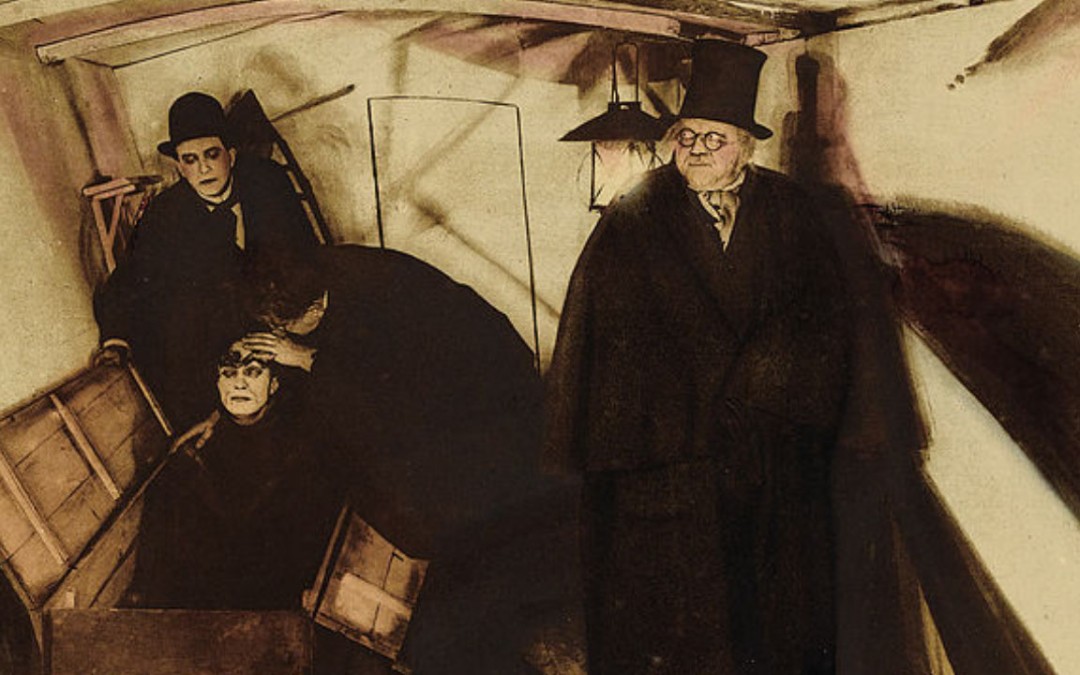The 1920s was a great decade in film. European production companies had just about recovered from the first world war, and Hollywood was cranking them out like never before. Camera technology was still on rather shaky ground, but it was good enough that several films of the 1920s are still today considered to be masterpieces. This was the decade when film production companies started commonly creating feature length films, rather than create mostly short films like they previously had. With films like Nosferatu, it was a great year for horror. But other genres were brought to the mainstream too – like dystopian fiction. It was during this decade when technology first allowed actors voices to be recorded and included in the films. Obviously this instantly changed the industry a lot, since less silent movies were produced and films could include real dialogue.

The Cabinet of Dr. Caligari (1920)
The Cabinet of Dr. Caligari is a horror film from Germany. It’s genuinely one of the most original and creepy films of the 1920s – which was a creepy decade. The film is about an insane magician, who hypnotises a young man to murder anyone who he is ordered to. He keeps the hypnotised man hidden inside a cabinet – hence the name. The set design is one of the most bizarre and dark of any film I have ever seen, which really adds something to the viewers experience. The film appears to be on a pretty predictable path at first. But things get harder to predict as it goes on. In fact, The Cabinet of Dr. Caligari had one of the great twist ending of early film.

The Gold Rush (1925)
The Gold Rush is one of Charlie Chaplin’s greatest films. He didn’t just star in it, but wrote and directed it also. He wanted this film to be the jewel in his legacy, the thing he was to be remembered for. Set during the Klondike Gold Rush, he plays a gold prospector who finds himself lost in the wilderness after getting caught in a blizzard. He soon discovers a mysterious wood cabin. Two other men are inside the cabin, one of them an outlaw. The three men agree not to fight each other, and peacefully wait out for the storm to end. On it’s release, critics declared it as one of the best films of the 1920s.

The Hunchback Of Notre Dame (1923)
You’ll be aware of the Disney version of The Hunchback of Notre Dame but this is what started it all. In film, anyway. It tells the story of a deformed hunchback called Quasimodo. Quasimodo was abandoned by his gypsy mother when he was a young child, but adopted by the church. As his deformity struck fear into the heart of most of the local villagers, Quasimodo lived his life locked inside Notre Dame cathedral and was never allowed to leave. Well, he is allowed to leave sometimes. Like when he was publicly lashed. This was his punishment for attempting to kidnap a gypsy girl. It really is one of the classic films of the 1920s that everyone should watch at least once.

The Phantom Of The Opera (1925)
The Phantom of the Opera is one of the most unintentionally funny movies of all time. It stars the same lead actor who played Quasimodo in the hunchback of Notre Dame. In this, he plays a deformed ghostly figure who constantly causes havoc at an Opera house in Paris. The film is disgustingly creepy and sinister at times, and disgustingly hilarious at others. The phantom attempts to murder anyone standing in the way of the woman he is in love with, who had dreams of starring in an opera show. The Phantom of the Opera has been remade several so many times that we tend to forget the 1925 version. But it’s worth remembering.

Robin Hood (1922)
Robin Hood is set in 12th century Nottingham. The set designers created a full size castle for the film, which made production a very lengthy and difficult process. In fact, the challenge of making the set almost forced the production of the film to be stopped. The film tells the story of an English noble who decides to fight back against an evil prince with his alias, Robin Hood. The movie was an instant success with both critics and viewers, being considered one of the best films of the 1920s by many.

The Last Laugh (1924)
The Last Laugh is a German silent film. But unlike most other silent films, The Last Laugh features no text that represents dialogue. The main character is a hotel doorman, which was a very well respected position at the time. But he is demoted to a simple bathroom attendant – for which he is mocked and shamed by those around him. His family even disowns him because of it. With his life in ruins, he slips into depression. He is soon made aware that a foreign millionaire has died and left him a fortune to inherit. So the doorman ends up being fabulously wealthy. He has the last laugh.

The Four Horsemen Of The Apocalypse (1921)
The Four Horsemen of the Apocalypse was the most successful film of 1921. That’s pretty good considering most top grossing films of the 1920s were comedies. The film tells the story of a very large and distant family. A wealthy landowner has family members in both France and Germany. The film is set during the first world war, and his family members end up fighting each other in battle as France was at war with Germany.

The Phantom Carriage (1921)
The Phantom Carriage is considered the greatest ever Swedish film. Production of the film was very unique, it is remembered for it’s use of flashbacks. In fact, flashbacks often occur during another flashback – it was like the original inception. The plot is that a trio of drunk idiots envoke an ancient legend. This causes one of them to be cursed. Cursed to drive the phantom chariot for the whole of the next year. With the phantom Chariot, his job was to collect people’s souls when they die.

Nosferatu (1922)
Nosferatu was the original vampire movie. In fact, it was an unauthorized film of the book Dracula. They simply changed the name “Count Dracula” for the extremely original “Count Orlok.” For this, they were inevitably sued for plagiarism and all copies of the film were ordered destroyed by a judge. Just one copy survived – and it’s a good thing it did because it’s one of the most creepy films of the 1920s. It tells the story of a Vampire who falls in love with a human woman, it’s such a creepy film though.

Metropolis (1927)
Metropolis allows us to see what the previous generations thought the future would be like. It’s set in a dystopian city where the working class is essentially enslaved by the political class, forced to work constantly. Their society is sharply divided, with each class distant from each other. But a very high status member of the political class falls in love with a member of the working class. His new love predicts an uprising by the working class, and things soon get a little dicey. It was one of the most expensive films of the 1920s due to it’s huge futuristic set design. It’s a really well made film that I recommend watching.

